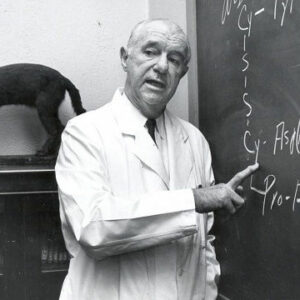His work on oxytocin and vasopressin, both related with the posterior pituitary, earned him the Nobel Prize in Chemistry in 1955. However, whereas the former induces uterine contractions and breastfeeding, the latter increases blood pressure by constricting arterioles and promotes water retention. His team also studied the hormones’ chemistry. He was the first to synthesize oxytocin, a protein hormone. He also succeeded in manufacturing penicillin. He also identified the peptide hormone insulin and the sulfur-bearing biotin. He had important responsibilities during his career. Professor of Biochemistry at George Washington University School of Medicine. He was Professor and Head of the Department of Biochemistry at Cornell University Medical College in New York City for nearly three decades. He taught chemistry at ‘Cornell University’ in Ithaca, New York. In addition to the Nobel Prize, he received the American Public Health Association’s Albert Lasker Award for Basic Medical Research in 1948 and the Passano Foundation’s Passano Award in 1955.
Early Childhood of Vincent du Vigneaud
Alfred J. du Vigneaud and Mary Theresa du Vigneaud had him on May 18, 1901. His father invented and designed machines.
In 1918, he graduated from Chicago’s Carl Schurz High School.
He earned his BS in Chemistry in 1923 and his MS in Chemistry in 1924 from the ‘University of Illinois’ under Professor C.S. Marvel.
A scholar at the ‘University of Pennsylvania’ from 1924 to 1925.
In 1925, Vigneaud enrolled at the ‘University of Rochester’ to study for a postgraduate degree under Professor John R. Murlin.
In his thesis, ‘The Sulfur in Insulin,’ he demonstrated that cystine is the source of disulfide in the peptide hormone insulin.
In 1927, he began postdoctoral research on insulin with renowned American scientist and pharmacologist John J. Abel at Baltimore’s “John Hopkins University.” He showed that insulin is a protein, proving that proteins can be hormones.
From 1928 to 1929, he traveled to Europe as a National Research Council Fellow, where he joined the Kaiser Wilhelm Institute for Leather Research in Dresden, Germany, with Jewish-German scientist Max Bergmann.
His academic career continued at ‘University College London’ and ‘University of Edinburgh’.
A Career of Vincent du Vigneaud
He returned to Illinois in 1929 and taught Physiological Chemistry at the ‘University of Illinois’ in Urbana-Champaign until 1932. In 1930, while still at the University, he joined the chemistry-focused fraternity Alpha Chi Sigma (X).
From 1932 until 1938 he was a Professor of Biochemistry and Chairman of the Department at the ‘George Washington University Medical School’.
In 1938, he traveled to New York City and became Professor and Head of the Biochemistry Department at ‘Cornell University Medical College’. He worked for the institution until 1967.
His Nobel Prize-winning research on oxytocin and vasopressin was undertaken at the ‘Cornell University Medical College’. His work on biotin, insulin, penicillin, and transmethylation brought him fame.
His team at Cornell determined the peptide hormone insulin’s molecular structure in the late 1930s.
He and his colleagues found in 1940 that coenzyme R and vitamin H are similar to the sulfur-bearing vitamin biotin, whose structure they established in 1941.
In the 1940s, he succeeded in isolating and analyzing the chemical structures of two neurohormones, oxytocin and vasopressin, connected with the posterior pituitary. In 1953, he became the first to manufacture oxytocin, a protein hormone. In 1954, he synthesized vasopressin.
In 1946, he and his associates produced penicillin, another ground-breaking achievement.
A.S.B.M.B. President 1951.
A Trail of Research in Sulphur Chemistry and Metabolism and Related Fields’ was published by Cornell University Press in 1952.
‘New York University’ and ‘Yale University’ awarded him honorary doctorates in 1955. The ‘University of Illinois’ bestowed this accolade on him in 1960.
From 1967 to 1975, he was Professor of Chemistry at Cornell University in Ithaca, New York.
He was a member of the American Philosophical Society and the National Academy of Sciences (1944). Foreign Member of the Royal Society in Uppsala (1950), Royal Society in Edinburgh (1955), and Royal Institution of Great Britain (1956). (1959).
The ‘National Institute of Arthritis and Metabolic Diseases’ and the ‘Rockefeller Institute’ also have Vigneaud on their Boards.
Honors & Awards
He won the Nobel Prize in Chemistry in 1955.
Personal Legacy of Vincent du Vigneaud
The chemistry instructor Zella Zon Ford.
Vincent Jr. was born in 1933, and Marilyn Renee Brown in 1935. Their sons became doctors.
His academic career was halted by a stroke in 1974.
On December 11, 1978, in New York, he died at 77.
Estimated Net Worth
Vincent is a wealthy and well-known biologist. Vincent Du Vigneaud net worth is estimated at $1.5 Million by Wikipedia, Forbes, and Business Insider.


